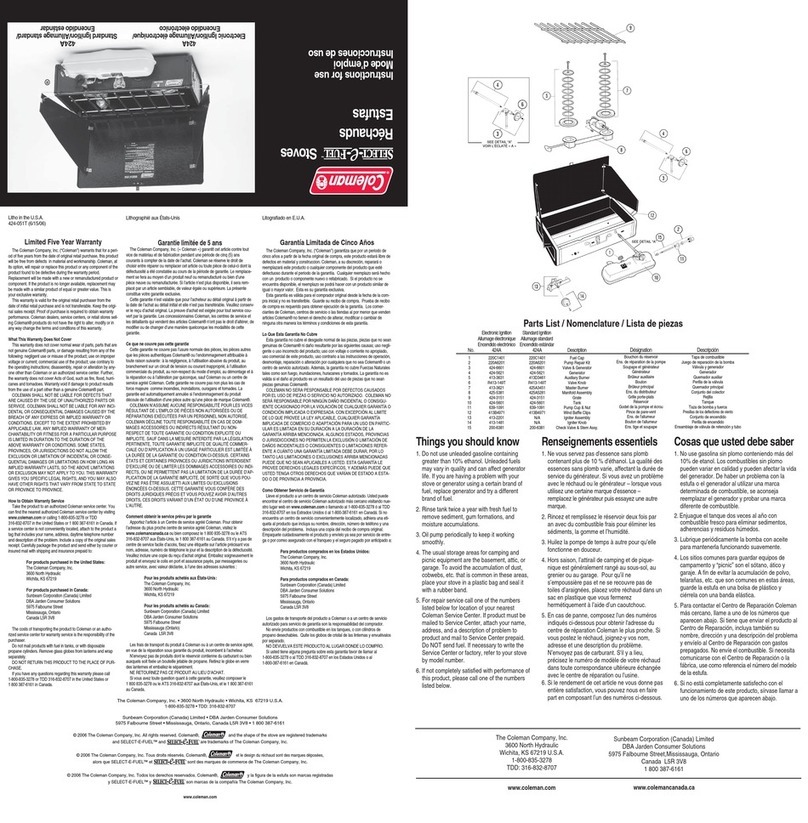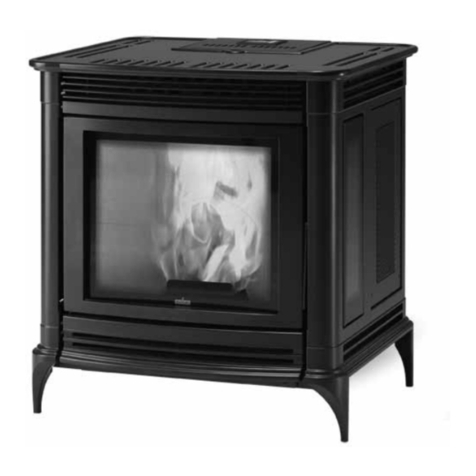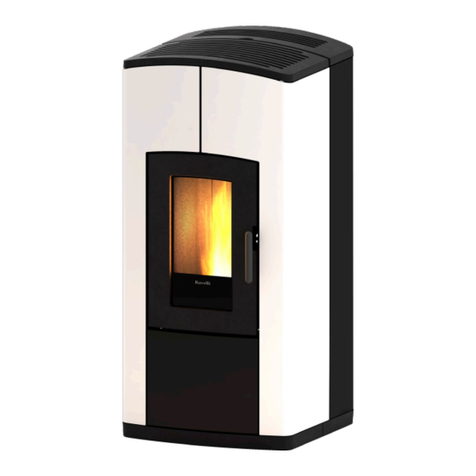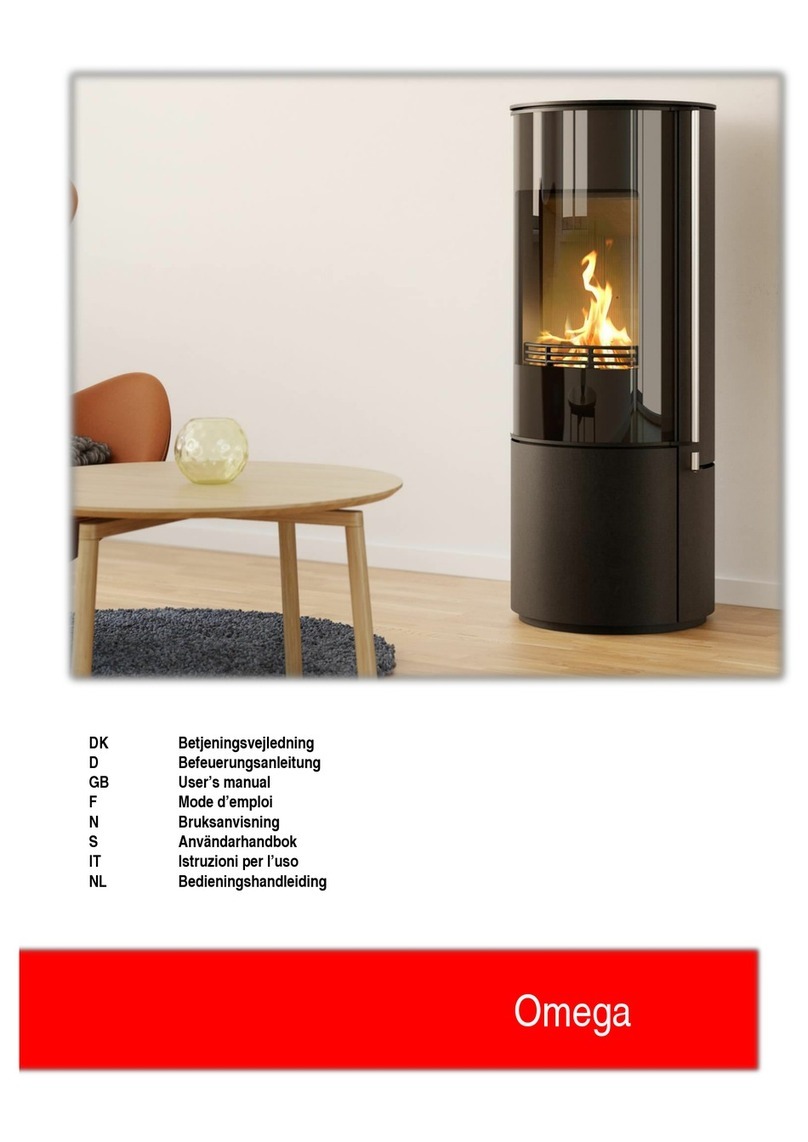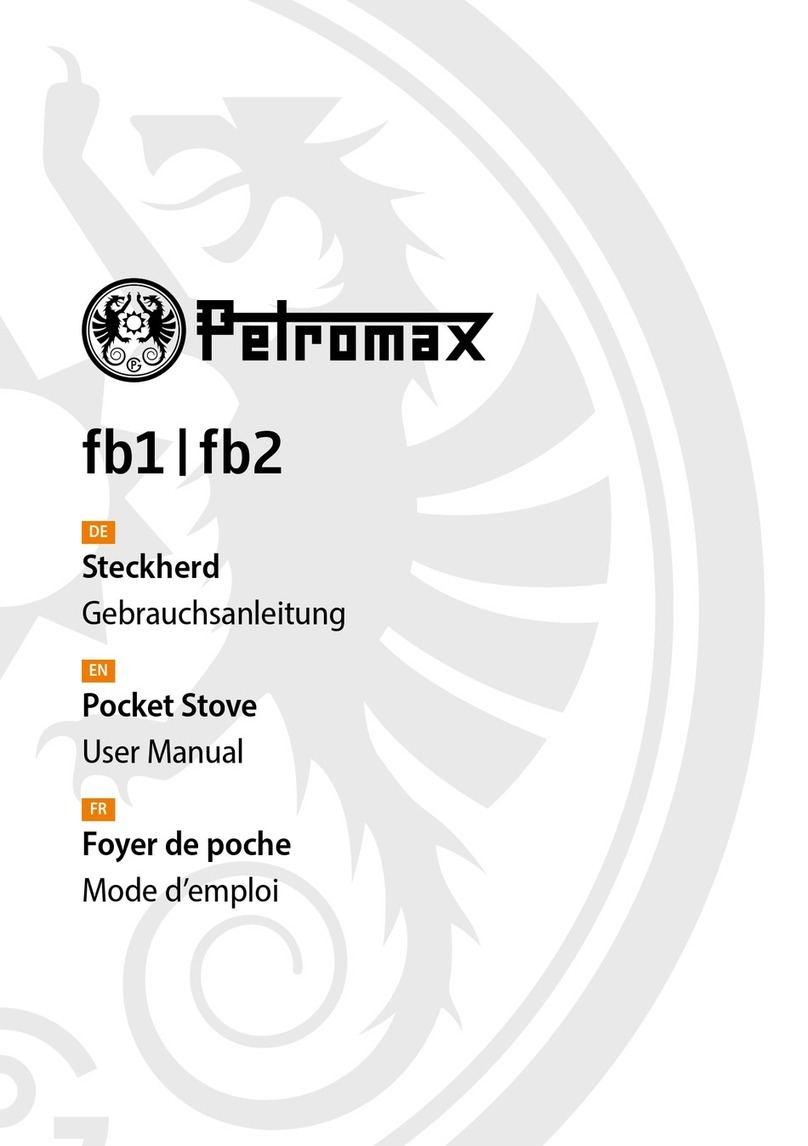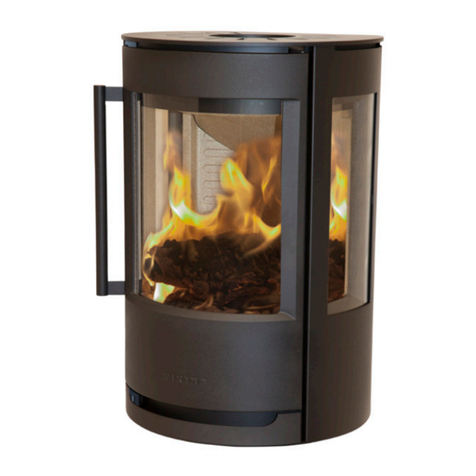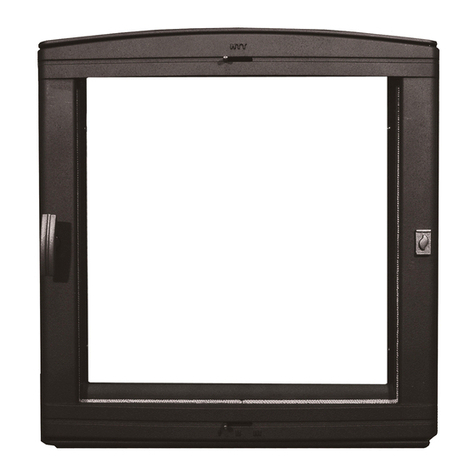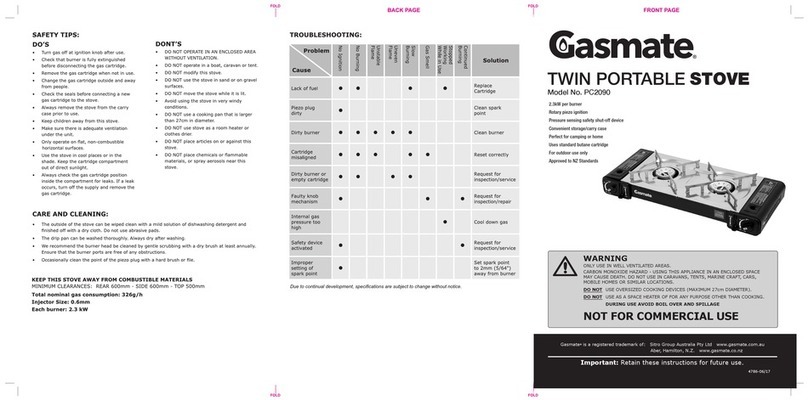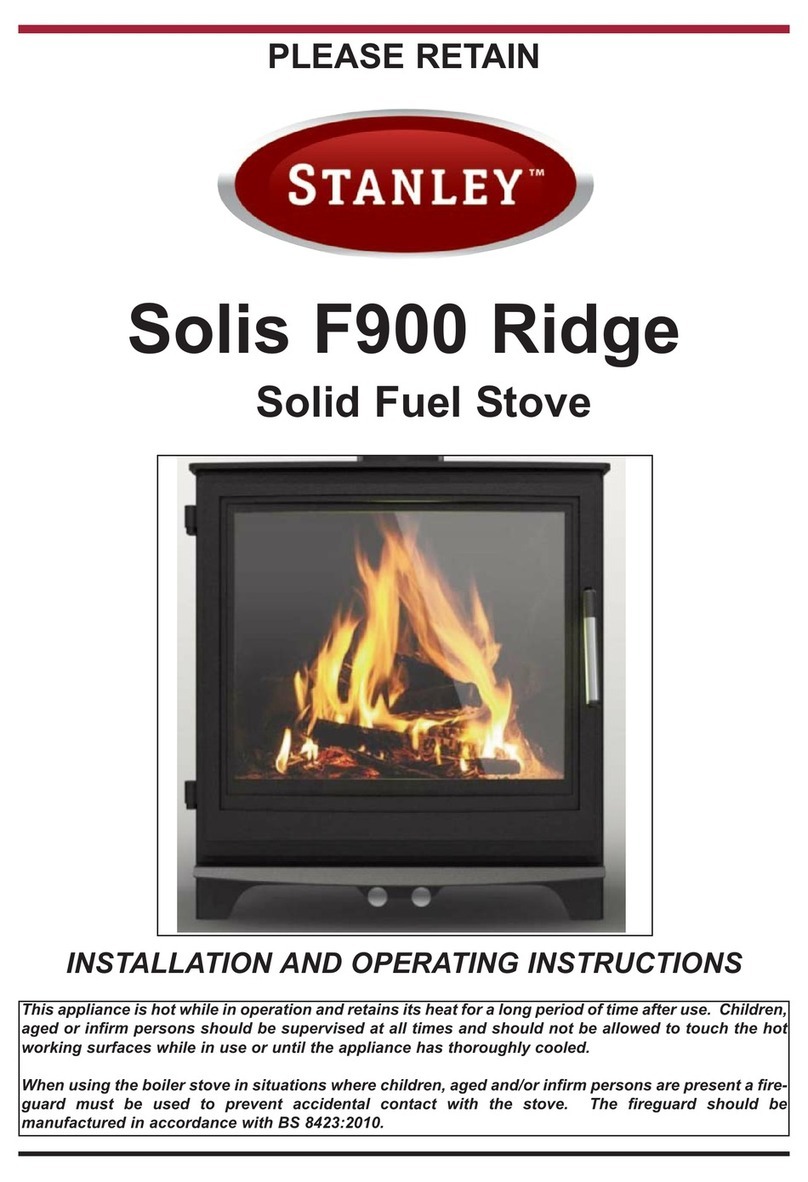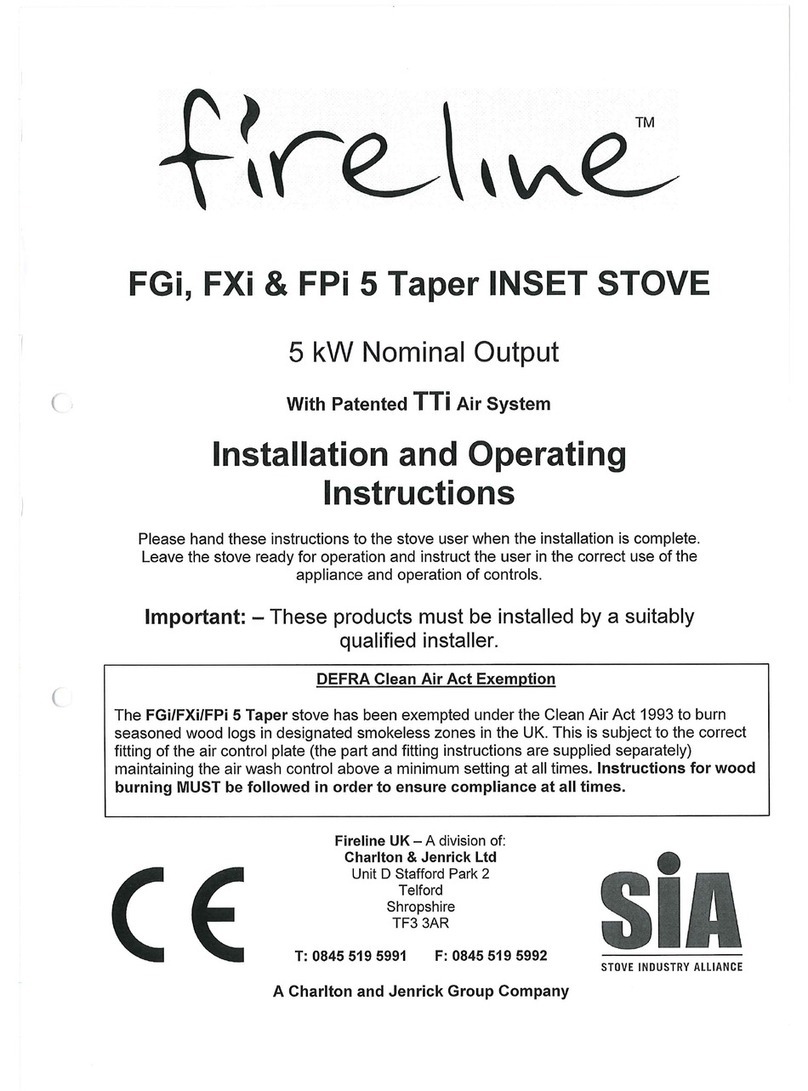Teuvan parra 14 User manual

Parra sauna stove
14, 21, 28 and Parra Q20
Installation and instructions for use
05/2022


PARRA SAUNA STOVE INSTALLATION, USE AND MAINTENANCE IN-
STRUCTIONS
Congratulations on your excellent choice of sauna stove! A PARRA sauna stove is a high-quality,
traditional Finnish product that will serve you long when used and cared for properly. This guide
describes the installation, use and maintenance of the stove. Read the guide carefully before using
the stove and keep it for further reference.
A PARRA sauna stove is a fireplace intended for heating a sauna. It is not intended for continuous
heating of an entire building. Only wood may be burned in a PARRA sauna stove.
WARNINGS
! Keep the door to the furnace closed to prevent smoke leaks except when lighting up the fire,
adding wood and removing ashes.
! The stove parts, in particular its outer surfaces, will be hot to the touch when used. Use caution
close to the hot surfaces.
! Modifications to the stove are not allowed.
CONSIDERATIONS
Prior to installation, the sauna stove must be stored in a dry place to prevent corrosion! Remove all
protective plastic before heating the stove!
Use the stove’s adjustable legs under all circumstances and on all surfaces. They increase the air
flow underneath the stove, keeping the platform dry.
Take care of the sauna's adequate air ventilation, thus extending the lifespan of the heater
and the sauna.

TECHNICAL SPECIFICATIONS
Table 1: TECHNICAL SPECIFICATIONS
Parra 14
Parra 21 / Q20
Parra 28
Sauna volume
7–14 m3
8–21 m3
10–26 m3
Connecting flue diameter
143 mm
143 mm
143 mm
Height of upward flue connection
637 mm
702 mm
777 mm
Back connection/diameter/height from centre of
aperture
●/ 110 mm / 555
mm
● / 110 mm /
580 mm
● / 110 mm /
652 mm
Temperature class required of the chimney flue
T600
T600
T600
Minimum size of replacement air aperture in the
sauna room
Ø100 mm
Ø100 mm
Ø100 mm
Height
645 mm
690 mm
755 mm
Width
430 mm
430 mm
430 mm
Depth
490 mm
490 mm
490 mm
Max. length of firewood
35 cm
35 cm
35 cm
Firewood diameter
10–15 cm
10–15 cm
10–15 cm
Approximate amount of stones
30 kg
35 kg
35 kg
Stone diameter
8–12 cm
8–12 cm
8–12 cm
Weight of the fireplace
50 kg
56 kg
66 kg
Water heater/volume
○ / chimney con-
tainer 30 l
○ / chimney con-
tainer 30 l
○ / chimney con-
tainer 30 l
Fireplace glass door
○
○
○
Adjustable legs
●
●
●
● standard
○ option

Height of the chimney connector
The heights of the chimney outputs of the Parra sauna stove models are shown in table 1 and the
figure above (size B). The effect of optional items installed on top of the sauna stove on the chim-
ney connector height is shown in table 2.
Table 2: Effect of Parra accessories on the height of the chimney connector
Accessory
Add to the height of the chimney connector
Water heater VS 30
525 mm
65° angled smoke duct
246 mm (to the centre of the duct)
90° angled smoke duct
177 mm (to the centre of the duct)
25 cm smoke duct
approx. 200 mm
75 cm smoke duct
approx. 700 mm
Figure 1: Height of the chimney connector

CE marking
Table 3: CE MARKING
13
EN 15821:2010
Teuvan Keitintehdas Oy, Keitintehtaantie 29, 64700
Teuva, Finland
Keitintehtaantie 29, 64700 Teuva, Finland
Continuous-heating wood fireplaces for saunas
Model
Parra 14
Parra 21
Parra Q20
Parra 28
Fuel
Wood
Wood
Wood
Fire safety: (ignition, risk to adjacent struc-
tures)
o
o
o
- safety distances
→ See table “SAFETY DISTANCES”
Combustion emissions
o
o
o
Surface temperature
o
o
o
Release of hazardous materials
NPD
NPD
NPD
Cleanability
o
o
o
Flue gas temperature in flue connector, °C,
(furnace doors closed) at nominal power
487 °C
464 °C
430 °C
Mechanical strength
o
o
o
Heat production to room space (kW)
13 kW
16 kW
18 kW
- carbon monoxide emission with 13% O2
concentration
o (0.18%)
o (0.36%)
o (0.41%)
- overall coefficient of efficiency
o (62%)
o (62%)
o (67%)
- flue draught
12 Pa
12 Pa
12 Pa
- fuel charges
4 + 2.5 kg
5 + 3.7 kg
5 + 3 + 2 kg
- ash box gap
25 mm
25 mm
25 mm
Flue gas mass flow
14.3 g/s
17.6 g/s
16.1 g/s
Declaration of performance - No: DoP-PK
https://teuvan.com/assets/pdf/DoP-PK.pdf
SAUNA STOVE INSTALLATION AND FOUNDATION
All local regulations, including regulations with reference to local and European standards, must be
adhered to when installing the fireplace.
Before installation
Remove all packaging material and protective plastic. Shining, stainless parts (decorative strips,
exterior of the furnace door, exterior surfaces of stainless models) may have a thin protective film,
which also must be removed entirely. The film must also be removed if the sauna stove is exposed
to sunlight when stored, as the sunlight may make the film difficult to remove.
Before placing the stones in the sauna stove, heat it to remove protective agents. Ensure sufficient
ventilation when doing this. It is recommended to do the first heating outdoors with a non-insulated
connector duct mounted to the stove to attain draught.

Sauna room size
A PARRA sauna stove san be installed in a sauna room whose size conforms to the size stated in
the technical specifications. Carefully select the sauna stove model, as you must consider the
properties that affect the heating of the sauna room when choosing the size of the stove. A sauna
stove with insufficient power must be heated longer and harder, making its useful life shorter. If the
sauna is made of timber but is not insulated and is used in the winter, the computational volume of
the sauna room is the real size multiplied by 1.5. For every unlined square meter of stone wall, add
1.2 cubic meters to the computational space. Similarly, every square meter of door or window sur-
face will increase the computational space by 1.2 cubic meters. Choose the sauna stove according
to the computational space you attain with these rules.
Placement
Install the sauna stove on a level, non-moving, stable and incombustible platform. The load-
bearing capacity of the floor must be sufficient considering the weight of the sauna stove, the water
heater, if any, and the flue. Use the adjustable legs (optional) to fine-tune the position of the sauna
stove and ensure that it is steadily level and does not wobble. The adjustable legs are mounted to
the flanges at the bottom of the sauna stove body. To adjust the height, turn the bottom nuts. Lock
the leg in place with a nut attached above the flange.
Flue
PARRA sauna stoves are connected to a CE-labelled PARRA flue, Parra chimney or a flue con-
formant to sections E1 and E3 of the National Building Code of Finland. The heat classification of
the flue must be at least T600 and it must be chimney fire proof.
PARRA sauna stoves are not suitable for installation in a shared smoke duct system.
A 30-litre water heater installed above the stove on the flue is available as an option. In this case,
close the rear connection.
Connect the sauna stove to the flue with a separately supplied angular duct or direct flue. Models
with a rear connection aperture can also be connected to the flue with a separately supplied rear
connection duct. In these models, close the second connection aperture with the supplied cover.
With a masonry flue, make sure you don’t obstruct the flue with the connector duct. You can insu-
late the gap between the flue and the connector duct with suitable mortar or incombustible and
heat-resistant mineral wool (minimum volume weight 100 kg/m3).

Furnace door
The door of the Parra sauna stove’s furnace is
packaged inside the furnace during transportation.
The hinge pin is in place in the body’s hinge flang-
es. Install the door so that the hinge flanges on the
stove body remain inside the door flanges. For de-
tails, see figure 2.
The door can be installed for right-handed or left-
handed use.
Safety distances
Table 4: SAFETY DISTANCES
Parra 6
Parra 14
Parra Q20
Parra 21
Parra 28
Safety distances combustible
materials
- sides
- rear
- front
- above
500 mm
500 mm
500 mm
1,200 mm
250 mm *
250 mm *
500 mm
1,200 mm
250 mm */***
250 mm */***
500 mm
1,150 mm
250 mm *
250 mm *
500 mm
1,150 mm
250 mm *
250 mm *
500 mm
1,500 (1,300 mm **)
Minimum distance (air gap) to
incombustible walls
50 mm
50 mm
50 mm
50 mm
50 mm
*) Can be reduced to 100 mm with the optional Parra sauna stove protective wall. In this case, the connect-
or duct’s thermal radiation shield is also needed. (Pls. see figure 4 in next page)
**) Requires the use of a radiation shield intended for the sauna stove
***)Can be reduced to 150 mm by using the U-shape (single layer) protective mantle of the Parra Q20 stove
which is available as an accessory. (Pls. see figure 5 in next page)
Figure 3: Parra-Stoves safety distances (without protective walls)
Figure 2: Furnace door hinge

Figure 4: Parra-Stoves safety distances with L-shape protective walls + radiant heat shield tube
Figure 5: Parra Q20 stove safety distances with single layer protective mantle + radiant heat shield tube

Protecting the walls
If necessary, the safety distances behind and on the sides of the sauna stove can be reduced with
optional Parra stove protective walls. This allows for reducing the safety distance to 100 mm on the
sides and behind the stove. The distance from the building wall and from the exterior surface of the
stove to the protective wall must be at least 30 mm to allow for air circulation.
When using protective walls, the uninsulated connection duct to the flue must be protected with a
Parra thermal radiation shield. With the thermal radiation shield, the safety distance of the uninsu-
lated connection duct to the wall is reduced to 150 mm. (pls. see figure 4)
Alternatively, the Parra Q20 stove can also be used with the optional single layer protective mantle,
that can be installed on the stove, with which the protective distance to the side and back is at least
150 mm measured from the surface of the stove (i.e. 120 mm from the surface of the protective
mantle), pls. see figure 5.
Protecting the floor
The sauna stove can be installed directly on a concrete floor with at least 60 mm concreting, if the
floor structures under the stove do not have parts susceptible to heat, such as electric wiring or
pipes.
Harmful heating of the structural part underneath the sauna stove must be prevented. The mortar,
glue and water insulation of a tile floor do not withstand the thermal radiation from the stove without
a shield. It is recommended to use the optional Parra sauna stove’s shield platform for protecting
the underlying structures. Use the sauna stove’s adjustable legs even with the shield platform. The
adjustable legs lift the stove, improving air circulation underneath it, which makes the shield plat-
form and the sauna faster to dry after the sauna bath. Carefully observe the instructions from local
fire authorities. If necessary, consult them for advice.
When installing on flammable floor, a Parra sauna stove’s shield platform or corresponding protec-
tive shield must be used. The floor area to shield in front of the stove must extend at least 100 mm
from the sides of the door and at least 400 mm in front of it. Shield this area, if necessary, with a
shield plate of 450 x 280 x 6 mm (optional), which attaches firmly to the floor and the stove plat-
form.
Stove stones
The recommended stones for the stove are peridotite or olivine diabase stones with a diameter of
8–15 cm. The stones must be washed before use. Lay in the stones so that you put the largest
ones at the bottom with the greatest stone surface against the stove’s steel surface. Put the stones
in the side pockets and generously, approximately 10–15 cm, over the centre channel. An appro-
priate amount of stones guarantees a good sauna bath. When laying in the stones, make sure that
the sweeping hole doors stay in place.

Ventilation
Make sure the ventilation in the sauna is arranged so as to guarantee enough supply air for com-
bustion and that the air in the sauna is fresh and has sufficient oxygen levels for sauna bathing.
The task of the ventilation is to also remove the humidity from the room after the sauna bath.
For combustion air, connect fresh-air duct with a diameter of 100 mm close to the sauna stove.
The grills for the supply air for the sauna must be placed so that they will not get blocked easily.
The burning consumes a lot of air, and natural ventilation will work well in wood-burning sauna as
long as there is fire in the furnace.
If the sauna space has mechanical ventilation, the supply air duct can also be placed over the
stove. In this case, install the exhaust air duct at the bottom of the sauna, preferably on the oppos-
ing wall. Air can also be exhausted from the washing room, in which case you need to leave a gap
of at least 8 cm under the door between the sauna and the washing room. When using mechanical
ventilation/exhaust fan, make sure that it will not cause excessive underpressure in the sauna
room, which may reduce the draught in the furnace and make it more difficult to light up.
Install a ventilation valve on the sauna ceiling or top of the wall. Keep it closed during the sauna
bath and then open to dry the sauna. Sufficient ventilation after sauna is necessary to guarantee a
long useful life of the sauna stove and the sauna.
Fuel
The fuel of a PARRA sauna stove is only natural chopped wood. The dimensions are shown in ta-
ble 1. The amounts of firewood used for heating the sauna stove or when adding wood are shown
in table 3. Make sure you do not fill the furnace past the top of the filling hole when you add wood.
The performance values shown in the table apply to birch firewood. Other wood can also be used.
To attain good burning, make sure that the firewood is dry.
Do not use materials with high calorific value, such as briquettes, coal, plastic or liquid fuels to
heat a PARRA sauna stove. They are specifically against the recommendations.
You can store an amount of wood suitable for a few uses close to a PARRA stove. The wood must
be placed so that its temperature will not exceed 80 °C.
Heating
Open the flue damper, if any, and empty the stove’s ash tray before heating. Use small, dry wood
for ignition. Then use the ash tray to adjust draught. At the early stages of heating, the ash tray
may be wide open. When heating, the ash tray may be open up to the 25-mm limiter. If you open
the ash tray, make sure not to burn the stove too hot. A small draught will reduce the amount of
wood needed but also prolong the time needed for heating the sauna. Usually, one full load of
wood is enough to heat up the stove. After this, add the amount of larger wood necessary to sus-
tain burning during the sauna bath.
Make sure that the supply air grills are clean and open.
If the sauna has been unused for a long time, make sure the flue is in order and open before you
light up the fire. The draught will be poor with a cold flue and under certain weather conditions. In
this case, start the fire with a small amount of wood. Closing the sauna door or windows may help
in the starting stages.
After finishing the sauna, add some wood to the firebox to burn and ventilate the sauna. This en-
sures drying of the stove and sauna. In addition, adequate ventilation must be ensured. With these
measures, you ensure the long life-time of the PARRA stove.

Water for steaming
The water you pour on the stove must be water suitable for domestic use. Impurities and minerals
in the water, such as soil, iron and salt, will reduce the useful life of the stove. The use of seawater
as sauna water is prohibited. If seawater is used as sauna (stove) water, the stove's warranty ex-
pires.
CLEANING AND MAINTENANCE
Empty the ash tray preferably after sauna bathing once the fire has been extinguished properly and
definitely before the next heating. Also clear out loose ash from the furnace. Ash in the furnace dis-
turbs the circulation of air, which shortens the useful life of the stove. Use an ash bucket or other
suitable place for emptying the ash tray of the stove and make sure that the hot ash will not pose a
fire hazard.
Make sure the ash table is intact and in place, supported by its holders.
The stove, connection duct and flue must be cleaned and swept regularly in accordance with the
regulations of the Ministry of the Interior. This is very important particularly if the stove has not
been used for a long time. In connection with the sweeping, the flues of the PARRA sauna stove
must be cleaned through the sweeping hole on top of the stove. The stove ducts are rather high,
which means that little soot will not essentially affect the heating of the stove. Also make sure that
the sweeping hole cover (and the cover of the alternative flue connector) are properly in place. In
connection with the sweeping, check the stove stones and remove the dilapidated ones. Replace
removed stones with new ones.
You can wash a PARRA stove externally with soap and water and dry with a soft cloth.
A qualified person must regularly service the stove. Use only original PARRA spare parts.
SAFETY INSTRUCTION
The stove will get very hot when used. Its surfaces will be burning hot. Consider this when moving
close to the stove and using it. Do not leave combustible materials within the safety distance of the
stove. Never cover the stove or the ventilation holes in its body.
In case of chimney fire, close the stove’s air regulator (ash tray) and flue damper, if one has been
installed. Keep the fire furnace door closed. Contact the local fire authority. Do not extinguish the
fire with water. A sweeper must check the stove and the flue after the chimney fire before the next
heating. To avoid a chimney fire, remember to sweep regularly and use only dry wood with suffi-
cient draught for the burning.
NOTE! Chimney fires, even extinguished ones, must always be reported to fire authorities.

WARRANTY
PARRA sauna stoves are covered by one-year warranty from their date of delivery. The warranty is
valid in Finland only. The warranty applies only to workmanship and materials. The warranty does
not cover cost of transportation, installation, wear and tear, faults from use in conflict with the oper-
ating instructions or any other expenses. The manufacturer will rectify possible errors either by re-
pairing the faulty part or supplying a new one. Under no circumstances will the manufacturer be
responsible for indirect or consequential damage. For more information on the terms of warranty,
visit our website at www.teuvan.com .
Product, serial number ____________________
Checked by _______________________
Part
Description
Type label
Ash table
Ash tray
Door
Hinge pin
Operation instructions
Flue connector shutter
Adjustable legs
Rear connector duct
Manufacturer
Keitintehtaantie 29, 64700 Teuva, Finland
Tel: +358 207 851 600
www.teuvan.com
This manual suits for next models
3
Table of contents
Popular Stove manuals by other brands

Superior
Superior MONIA Instructions for installation, use and maintenance

Meg Stoves
Meg Stoves 4.5 Pod Instructions and installation guide
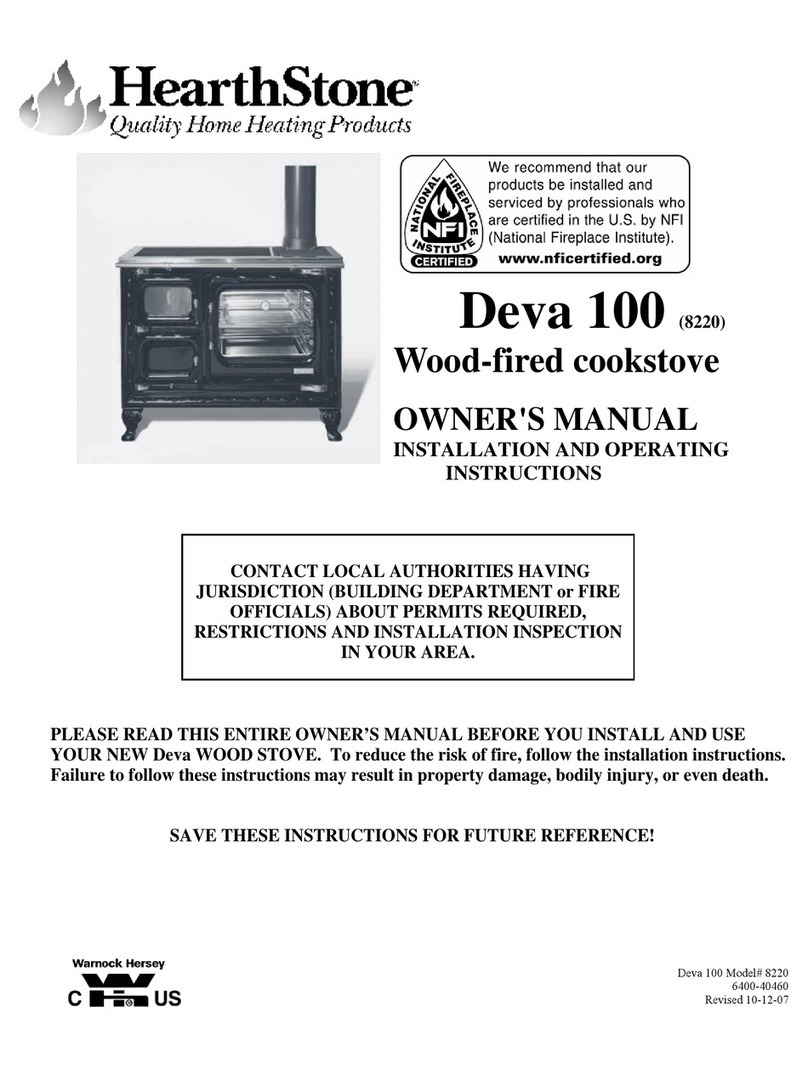
HearthStone
HearthStone Deva 100 owner's manual
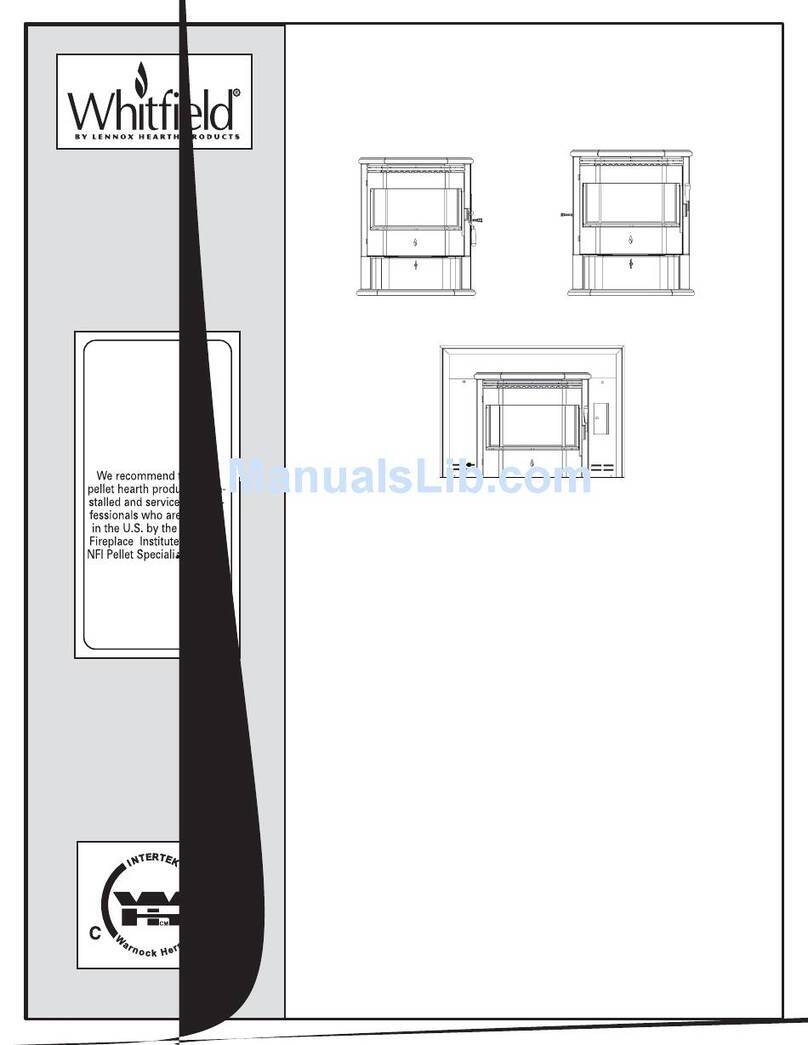
Whitfield
Whitfield Profile 20 FS-2 Installation and operation manual

FOTILE
FOTILE GAG76202 user manual

BioLite
BioLite CampStove instruction manual
